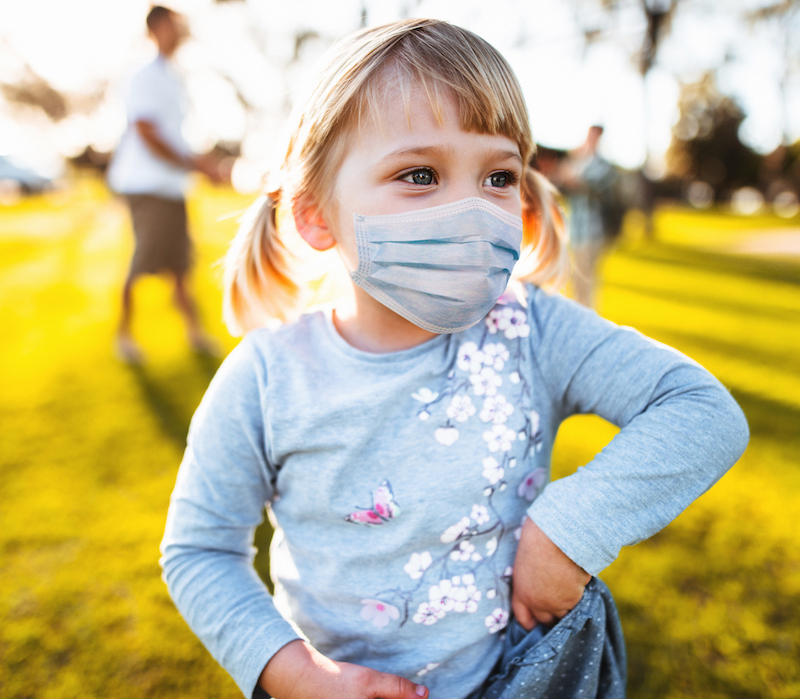Topics

PHOTO: Getty Images
As the COVID-19 pandemic continues, we know you have to make many adjustments to stay safe and make hard decisions for your child about childcare and school attendance. It’s hard for us to give specific advice about these difficult choices because different schools or daycares may have different risks and even children with the same condition may have very different severity of lung disease. Although we cannot take the risk of contracting the virus away completely, this blog offers information about helping your child wear a face covering correctly as part of your efforts to reduce his or her risk of SARS-CoV-2 infection (the virus causing the COVID-19 pandemic).
If your child is going to go to school in-person, it’s important to help your child be as safe as possible. Many schools are requiring use of masks, though it varies what age or grade they will require them. You will want to help your child know how to stay safe and pick the right type of face covering. While you wear a face covering mainly to protect others, the mask may have some benefit protecting you and your child as well.
Three crucial measures help control the spread of COVID-19:
- Wear a face covering
- Stay at least 6 feet (about the length of a standard bicycle) away from people who do not live in your household (social distancing)
- Wash hands regularly
It is advised that everyone over the age of 2 should wear a face covering when in public or in places where there could be exposure. Children less than 2 years of age, people who have developmental issues or severe lung disease may not tolerate a tight-fitting face covering. Anyone who would have trouble removing a face covering without assistance should not wear a face covering. It’s best to avoid touching your face or eyes as your hands may get germs on them. If your child touches his or her face more while wearing a mask, that is not ideal.
What type of face covering is best?
Face coverings can be medical masks (surgical or procedure) style or fabric masks with 2 or more layers.
Your face covering should contain at least two layers of fabric, most commonly cotton. Additional layers or different types of fabric may provide additional barrier protection, but may also cause greater discomfort or shortness of breath. Bandanas and neck gaitors are not good options and can let too many particles through them.
There are some videos that help to show why wearing a mask is important and what masks works best. Researchers in Florida showed the effectiveness of various types of masks with sneezing mannequin. Your child may understand more by seeing how far a sneeze or cough can travel and the particles in the air you breathe.
Make sure you purchase enough masks to have back-up masks so that if your child gets it wet, dirty or loses it, you have more. Ideally, you should wash your face covering every day and change it at least once a day.
Talk to the school about how your child will eat and take other breaks from wearing the mask. You have to be sure to have breaks to drink water as well, especially if your child is out in the heat.
How do you put on a mask/face covering correctly?
You can model for your child how to put on and wear a mask correctly:
- Wash your hands with soap and water or an alcohol-based (>60% ethanol) hand-sanitizer for at least 20 seconds prior to putting on, touching, adjusting or removing your face covering.
- Place the bands around your ears or secure on the back of your head.
- The top of the covering should fit securely over your nose, covering your entire nose, mouth and chin.
- Take care not to touch the center of the mask.
- You should not let the mask sit under the nose – the nose should be covered all the time just like the mouth. Ideally, there should not be big gaps on the sides of the mask. The mask should cover the chin.
How can I help my child wear a face covering?
- Remember to always wear your face covering as you are your child’s biggest role model.
- Put the mask on a stuffed toy to show the child how it works.
- Show your child pictures of other children wearing masks.
- Talk about being a superhero with a mask to protect others.
- Help your child decorate the mask if that is allowed in school.
- Practice often at home so child gets used to wearing the mask and not touching or pulling on it. Give your child positive feedback for good behavior.
There are other good online resources you will want to check out for information about using masks and talking to your child about COVID-19. HealthyChildren.org, published by the American Academy of Pediatrics, has many good articles related to COVID-19 including talking to your kids, child care, school, masks, and getting outdoors. The main site has a link to all pandemic-related information and parents can learn more about face coverings here.
Masks for public use shows different types of masks for the public and for health care workers. The World Health Organization (WHO) includes videos on how to wear a mask correctly and the American Thoracic Society shares more information about face coverings in a pandemic.



